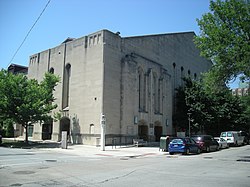After the 1896–97 season, based on a lack of material and disinterest by participants, the university suspended its men's basketball program and promoted the women's program instead. Finally, in 1903 the program was reinstated and, with the Western Conference backing a conference champion, a varsity schedule was developed by athletic director Stagg. Wilfred Childs became the head coach of the Maroons for this newly developed team that finished the season with seven wins and zero losses, beating teams by an average score of 45–11. [5] Childs would coach the Maroons through the 1905–06 season, turning the position over to Joseph Raycroft who would guide the team to four Big Ten Conference championships (then known as the Western Conference), and 1907, 1908, and 1909 teams were all retroactively named national champions by the Helms Athletic Foundation; [6] his 1909 team was also retroactively named the national champion by the Premo-Porretta Power Poll. [7]
Intercollegiate national championship
In March 1908, Pennsylvania, champion of the Eastern Intercollegiate Basketball League, issued a challenge to the Western Conference to meet its champion in the post-season to determine the national champion. Chicago and Wisconsin finished the regular season tied for first place in the Western Conference. [8] Representatives of the schools agreed to stage a single game to break the tie and determine which team would play Penn for the national championship. Wisconsin won a coin flip for the right to host the game. [9]
Chicago defeated Wisconsin, 18–16, on March 12, 1908, in front of 1,800 spectators at the Red Gym in Madison. After the Maroons took a 9–7 halftime lead, the Badgers surged in front briefly in the second half, before Chicago seized control of the game. Senior captain John Schommer and junior Robert Harris tallied five points apiece, each scoring one basket and sinking three free throws, to lead the Maroons. Frederick Falls added four points, all on free throws, for Chicago. Biddy Rogers, Wiconsin's senior captain, scored six points, all from the charity stripe, to lead the Badgers, but he missed seven of his 13 attempts. Visiting Chicago fans stormed the court after the game and carried the Maroons players to the locker room. [10]
The best-of-three national championship series was scheduled to begin at the teams' on-campus gyms in Chicago on March 21, and in Philadelphia on March 25. If necessary, the third game was to be played on Columbia's home court in New York on March 28. The first ever postseason games to determine a national champion attracted interest across the United States, and basketball critics generally agreed that the teams were worthy representatives of the eastern and western parts of the country. [11]
A crowd of 1,800, thought to be the largest ever to attend a basketball tilt in the west, witnessed the first game of the intercollegiate national championship series at Bartlett Gymnasium. With Pennsylvania leading, 12–10, in the first half, Frederick Falls passed the ball to John Schommer, who had his back to the basket about 20 feet behind him. Schomer, without turning around, lifted the ball over his head and shot the ball through the rim, tying the game. The score was deadlocked at 13 at halftime. With the Maroons trailing, 17–16, in the second half, Schommer scored two baskets from long-range, sparking a decisive 5–0 run. Chicago held the Quakers to just a free throw the rest of the way and secured a 21–18 victory. Schommer finished with eight points, and Falls led the Maroons with 11 points but shot only 7 for 15 from the free-throw line. Charles Keinath shot 12 for 14 from the charity stripe and finished with a game-high 12 points for the Quakers. [12] [13] [14]
The largest crowd ever to attend a basketball game in the city of Philadelphia witnessed a tight contest at Weightman Hall that neither team led by more than three points. Fierce guarding by Pat Page made it difficult for Quakers star Charles Keinath to get shots at the basket. Keinath committed 11 fouls in the game, mostly trying to escape Page. With the score tied at 15, Frederick Falls gave the Maroons a lead with a free throw. In the closing seconds, Keinath, who was visibly tired from being hounded by Page, missed a pair of free throws, and Chicago held on for a 16–15 victory and the national championship. Falls finished with a game-high 10 points, all from the free-throw line, to lead the Maroons. Keinath scored nine points for Pennsylvania. [15] [16]





